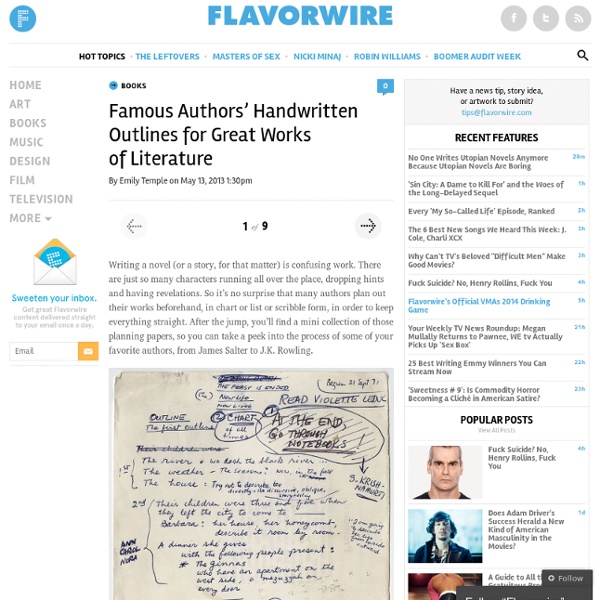



Charts and Diagrams Drawn by Famous Authors Being the literary nerds that we are over here, we’re obsessed with everything about our favorite authors, and particularly the little scraps of writerly intention — things that give us a view into an author’s thought process and planning technique, or even just a peek at the way they see and order the world. Plus, we like to see that authors work out their thoughts with forced attempts at organization and scribbled-out ideas just like the rest of us. Writers often use plot charts to organize the threads of complicated stories, but they’ve also been known to crank out diagrams of the travels of other people’s characters, chart-style teaching tools, and even hand-drawn maps. Jack Kerouac.
25 Things To Know About Writing The First Chapter Of Your Novel 1. Every Book A Hook (And The First Chapter’s The Bait) A reader walks into a bookstore. Spies an interesting book. What does she do? Picks it up. 2. Bring the reader to the story as late you possibly can — we’re talking just before the flight leaves, just before the doors to the club are about to close, just before the shit’s gonna go down. 3. A great first line is the collateral that grants the author a line of intellectual credit from the reader. 4. I’ve been to multiple Christopher Moore book talks, and each time he reveals something interesting about storytelling (and, occasionally, whale penises). 5. If I get to the end of the first chapter and I don’t get a feel for your main character — if she and I are not connected via some gooey invisible psychic tether — I’m out. 6. I want the character to talk. 7. Yeast thrives on sugar. 8. The reader will only keep reading if you provide them with an 8 oz porterhouse steak and — *checks notes* — oh. 9. 10. First impressions matter. 11.
How to layout a book in Microsoft Word This is a guide to formatting your book in Microsoft Word (2010)... I'll also be adding a video soon! Getting started Open a new document. Click “size”>> “More paper sizes” and set the document to 6”x9” (or your book size). Then set the margins and gutter. I set this one to 1" margins on the top and bottom (a bit too much on the top). Copy and paste your text into the document (or, if you’ve already been writing in Word, save the document as a new file (to be safe) and then start formatting. Setting Paragraphs Highlight some text and click on the "line options" tab. Make sure there's no space before or after the paragraph, and justified text. Then select the first paragraph of your book, click line spacing options again, but set the first line indent at 0.0. Chapter Pages Next, we’re going to separate all the chapters. So put the cursor before any of the text, go to “Page Layout” >> “Breaks” and “Next Page.” (I've changed the font to no-indent, black, and "Bebas Neue.") I’ll align right.
How to Write a Synopsis of Your Novel by Glen C. Strathy* To sell your novel, you may need to know how to write a synopsis, even if you are a pantser-type novelist who can write a whole novel without making an outline first. Agents and publishers will often ask for a synopsis along with sample chapters before they request a complete manuscript. The biggest mistake most people make when they try to write a synopsis for the first time is to create a bare bones plot summary, along the lines of “First this happens, then this happens, then this happens...” Synopses written this way tend to be so dry and boring even the author would have trouble understanding why anyone would want to read the full novel. Imagine, for example, if a sports writer described a hockey game as “First one team scored. What makes a hockey game or a novel mesmerizing is not a step-by-step description of what happens, but the emotions that accompany the actions, the anticipation, fear, hope, excitement, and disappointment at each turn of events.
CreateSpace Community: How to Write an Effective Book Description How to Write an Effective Book Description One of the most crucial elements to selling a book is also probably the most difficult element to create for authors. The book description is your lead in, your chance to hook a reader and get them to crack the cover and satisfy their curiosity. Even in an online environment, the book description can bridge the gap between having just another title among a sea of choices and a sellable book worth reading. The problem is that many authors have a hard time writing a good book description. The main reason it can prove so difficult is because they don't want to leave anything out. Elements of the Book Description As someone who has failed and triumphed over book descriptions, here is what I have learned through my personal series of trial and error. 1. 2. 3. 4. 5. Those are my five main points when it comes to writing a book description. Here's an example of a book description that I believe gets it right. You may also be interested in...